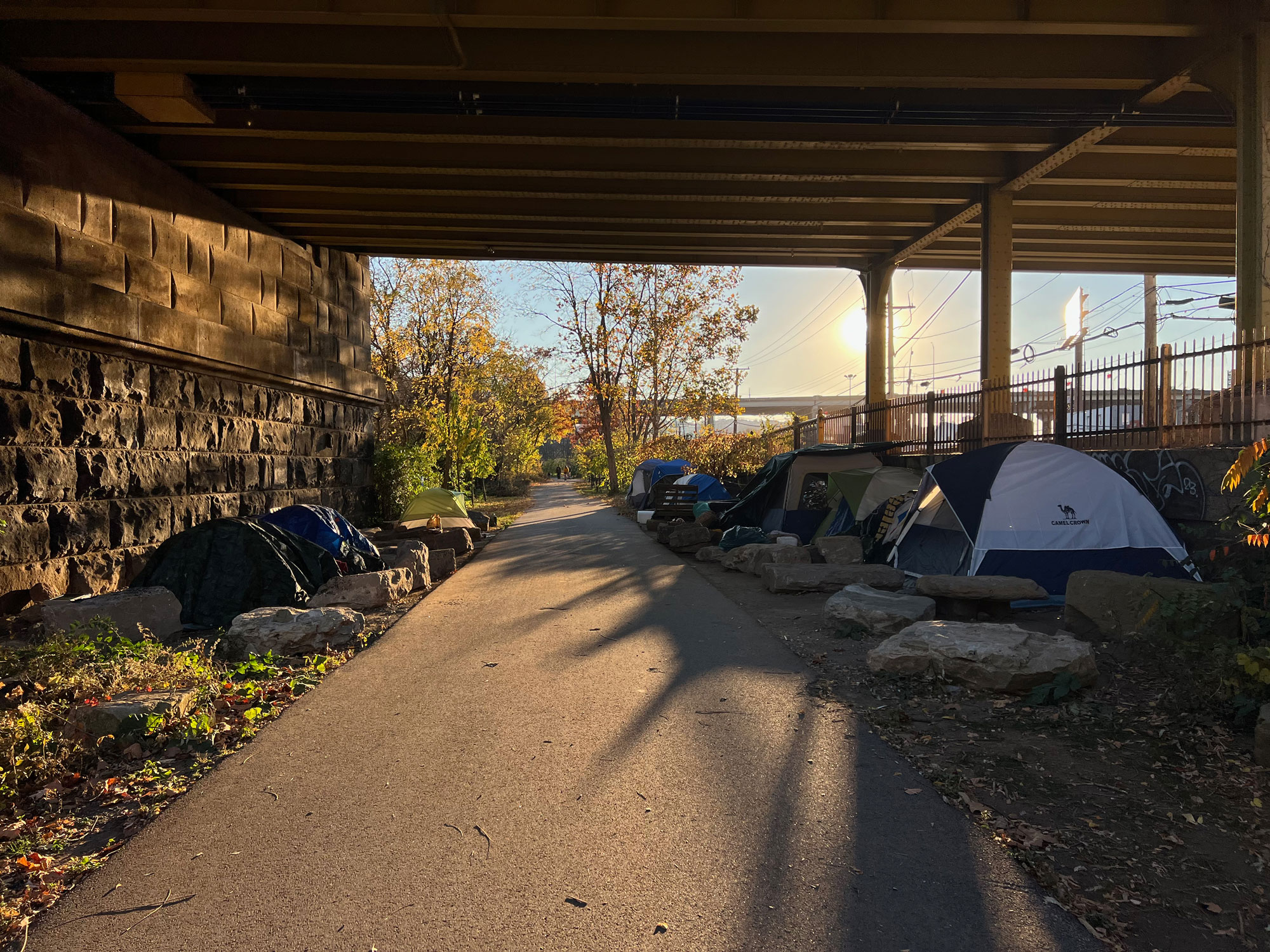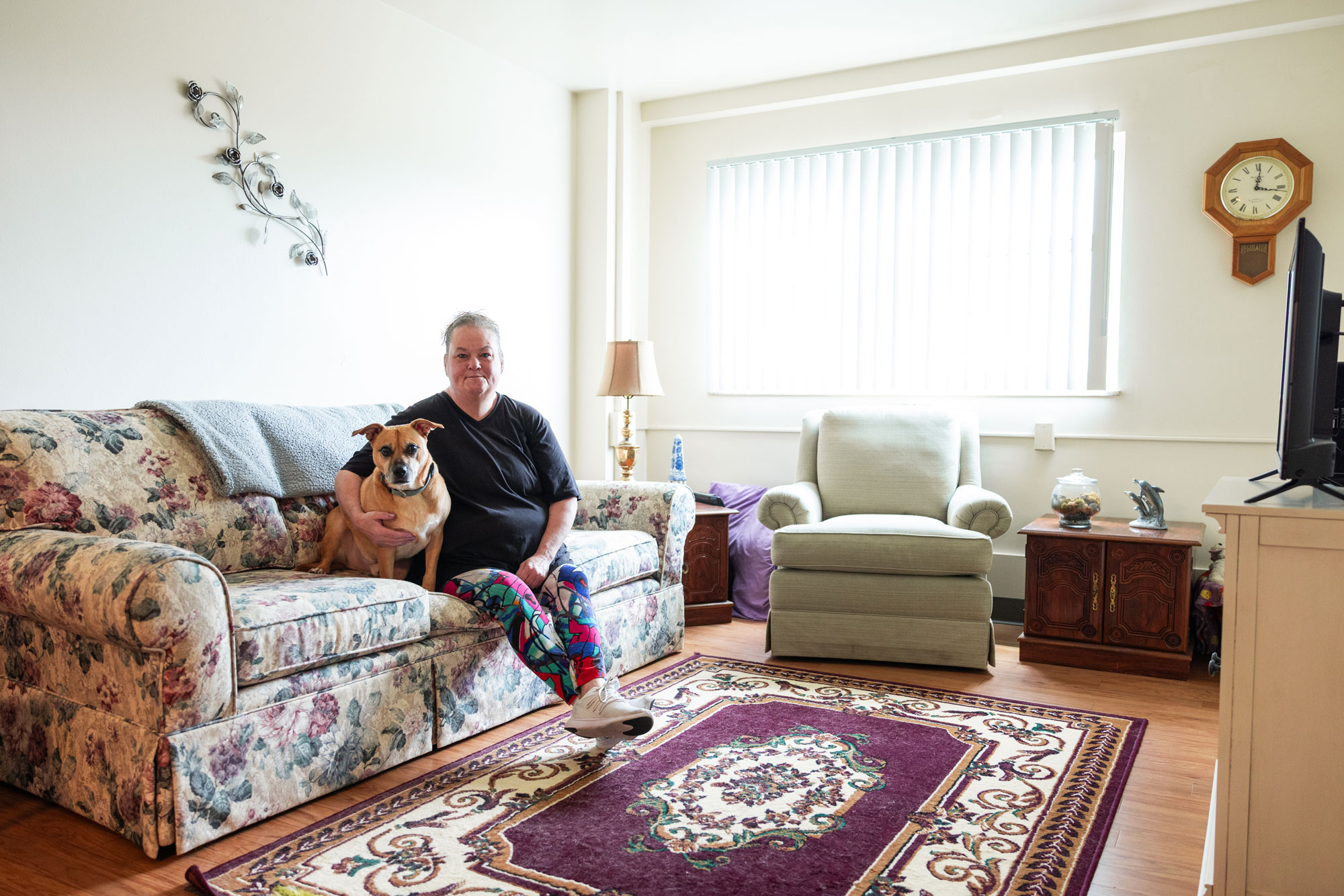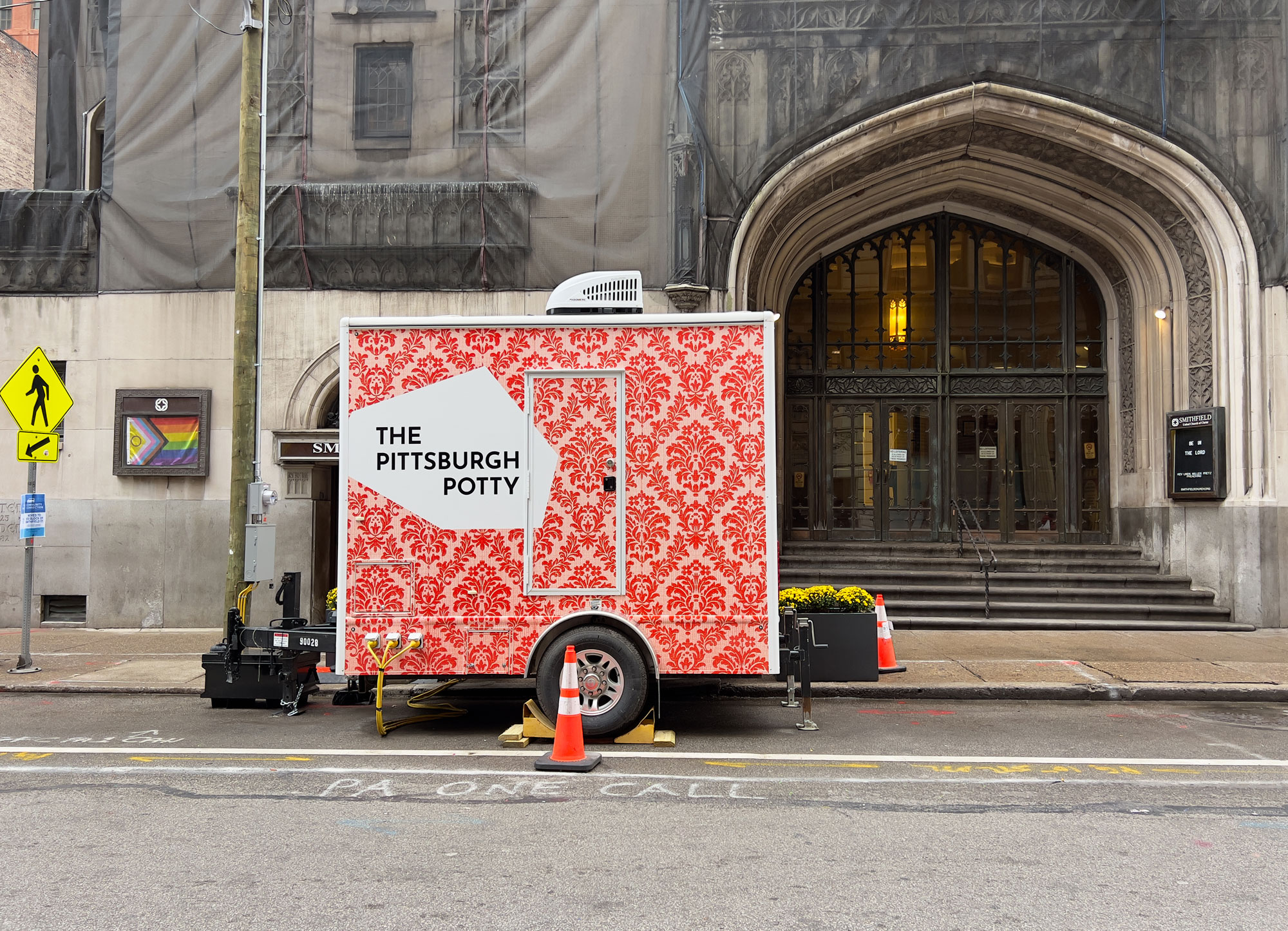Housing
Allegheny County housing plan has a 500/500 chance of success
The initiative to create 500 units in 500 days is producing tangible benefits – and could be a model for other regions in the state and nation.

Nate Cornelious in the kitchen of the apartment he secured through Allegheny County’s 500 in 500 program. ALLEGHENY COUNTY
On a morning in mid-June, Nate Cornelious proudly showed off the Penn Hills Township apartment he’d moved into the previous month, posing on a black-and-white sofa, accessorized by geometric black-and-white cushions, bespoke in a matching black-and-white Steelers polo shirt and sneakers that seemed hardly coincidental given a lifetime spent in Allegheny County.
Having once lost everything to alcoholism, Cornelious, 65, takes nothing for granted. For the one-time high school basketball star from Homestead, getting sober was a lengthy and brutal endeavor, and it left him adrift until, with the help of his pastor, he landed at Pittsburgh’s Second Avenue Commons shelter.
That was when Cornelious got lucky: His shelter social worker recommended him for one of the apartments made newly available through Allegheny County’s 500 in 500 program – and within a week of the news, he and his trusty bike (black and white, of course) moved in. “You just can’t go to the shelter and sit around. You got to want to get off the streets,” reflected Cornelious, who pays $50 a month for his subsidized unit. “I wanted to get out of this situation. I believe that God had a purpose for me, and I’m just grateful that I’m here.”
In addition to divine providence, Cornelious is among the first cohort of beneficiaries of the signature housing initiative of Allegheny County’s first-term executive, Democrat Sara Innamorato, who took office in 2024 with homelessness at the top of her agenda. Driven by skyrocketing housing costs and a paucity of homes, Allegheny saw its rate of unsheltered homelessness more than double between 2021 and 2023, from 65 to more than 150 people, according to federal statistics.
“500 in 500,” as it is dubbed, is the coordinated, multi-agency county effort Innamorato spearheaded to address the crisis by providing 500 previously unavailable units in as many days, along with the social supports to help tenants rebuild stable lives. One of those units was Cornelious’ newly rehabbed apartment, reserved for seniors, in a circa-1985 high-rise owned by the Allegheny County Housing Authority. He was among nearly 400 formerly homeless people who, by the program’s one-year anniversary this past June 6, had moved into 276 units. Most were studios and one-bedrooms, and slightly more than half were publicly owned.
“That’s (roughly) 400 people whose lives are now stable and aren’t sleeping on the floor, and don’t have to bring their items with them everywhere they go when the shelter closes,” said Innamorato, a Pittsburgh native and former state representative. “That’s a huge difference in people’s lives. It’s a huge difference in our safety and our regional economy. And it’s the power of applying innovative thinking to systems that already exist.”
By that, Innamorato means that the county isn’t building new houses from scratch – nor has it appropriated vast amounts of cash to subsidize a massive new program. Instead, the program is a patchwork in every sense – beginning with the unprecedented level of collaboration between the county executive’s office, Housing Authority, Department of Human Services and various other social service agencies.
The units, meanwhile, are a rehabbed mix of previously vacant or dilapidated county-owned units; privately owned, subsidy-eligible dwellings; and, in some cases, newly built, purchased or renovated buildings, including set-aside units in new developments incentivized by tax credits.
Given the program’s ad hoc nature, revenue flows from various sources, so there’s no official budget. (County DHS Director Erin Dalton did say that five area foundations have awarded a combined $3.4 million to bolster the program, paying for renovations along with increases to shelter capacity and case management to identify and house tenants.)
“For the most part, there was no cost for us acquiring the units. We already had these units that were public housing, or tax credit units that we developed over the years,” said Rich Stephenson, the longtime chief of Allegheny County’s Housing Authority, which owns some 3,800 housing units and manages rentals via an additional 6,800 vouchers through the federal housing assistance program known as Section 8. “The real costs are subsidies for rent and services.”
Traditionally, he said, DHS and emergency-shelter organizations provide rent for a few months, but not long term. “So this ended up being a very good partnership with the County Housing Authority, because virtually all of our homes are subsidized in some way,” he explained. “The Allegheny County DHS didn’t have to worry about paying the subsidy or the tenant paying their rent. And it’s better for us when units are occupied.
“And hopefully, many of the residents that we’re bringing in from the shelters, we’re able to get them back on their feet, back in the workforce,” he added. “Maybe they move on and open up that unit for somebody else who is coming through the shelter. So this is going to be a long-term relationship.”
The new demographics of homelessness
The crisis that prompted Innamorato’s initiative is playing out across the commonwealth and, indeed, the nation. In 2020, for the first time in U.S. history, unsheltered homelessness surpassed sheltered homelessness – a phenomenon that policy experts say is driven by an unprecedented run-up in housing costs, while low housing supply and stagnant wages are contributing factors.
The cost of purchasing a home surged 55% in Pennsylvania between 2019 and 2025; in Allegheny County, median home prices rose 10% from 2019 to 2020 and another 17% by 2024. Rising interest rates depressed the number of buyers and shrunk the available housing supply, while pandemic eviction moratoria largely froze the rental market in 2020, further contributing to the supply-demand imbalance.
These economics have been particularly cruel to seniors, a demographic for whom homelessness has tripled over the past decade in the Pittsburgh area. “These are older adults that have worked and paid into the system, and they’re just much more vulnerable today,” Dalton said, citing older people’s fixed incomes and limited affordable housing options.

Aiming to meet the soaring demand, the county added 243 year-round beds to its 23 single and family shelters between 2020 and 2024, for a current total of 776 beds. Still, these measures have proven insufficient in the face of, most recently, a 50% annual increase in people using adult and family emergency shelters, said Courtney Lewis, Dalton’s senior adviser at DHS.
Many of the new homeless fall into a growing category largely driven by the precipitous rise in housing costs: people whose previously stable lives were derailed by financial strain but who, if afforded stable housing and social supports, would be able to rebuild functional, socially integrated lives.
“These are individuals that, but for economic purposes, would be stably housed,” said Ed Nusser, Innamorato’s director of housing strategy. “But those affordable apartments that used to be available on the market for an individual to find a week after they lost their current home – those opportunities simply don’t exist anymore. It’s our job to restore the safety net for those individuals.”
They are the target demographic for the 500 in 500 program, which aims – through a complement of county- and grant-funded social services – to permanently end homelessness for its tenants. Exiting the shelter, said Dalton, means coming up with a deposit, first and last month’s rent and furnishings – which, taken together can cost many thousands of dollars.
“We have a lot of services for the chronically homeless – the people that people more typically think of as homeless – supportive housing, that kind of thing,” said Dalton. “But we really didn’t have anything in place for this relatively speaking lower-risk group, who just need a helping hand to get out of shelter.”
They are people like Deborah Gibson, a 53-year-old former teacher who recently relocated into a one-bedroom public housing unit in North Braddock. Most recently, she’d been living in a tent on the streets of Pittsburgh.

Gibson’s life wasn’t always so complicated. She grew up in Westmoreland County, earned a teaching degree from Indiana University of Pennsylvania and taught elementary students for years in Georgia public schools.
When her elderly parents became ill, Gibson, an only child, moved back to care for them until they died. Meanwhile, medical problems prevented her from returning to teaching – and when a romantic relationship turned abusive, she fled to Pittsburgh’s Second Avenue shelter. She left after clashing with the shelter’s administration, but a social work team followed up at her tent and put her on the list for 500 in 500.
“There are extremely wonderful resources out there, if people just listen and follow what they tell you,” said Gibson, who was particularly gratified that her service dog, Baxter, was allowed to come with her. She pays $50 monthly, receives food stamps and is in the process of applying for disability assistance.
When Gibson moved in, county social workers stocked her kitchen with food from local charities and took her to pick out furnishings: a couch, a chair, a kitchenette set and a dresser for the bedroom. “They brought it in, set it up, and, boom, I was furnished,” said Gibson. “I have a roof over my head; in my world, that’s all I need.
“My little mantra that I tell everybody is, don’t risk the roof,” she added. “You don’t want to ever do anything that anyone would deem improper and you might lose your apartment. So I try and stay very much in a straight line.”
Supply and demand
So far, 500 in 500 looks like a success that could serve as a model for other municipalities struggling to house residents.
But Allegheny County’s rehabbed public and subsidized units do little to address the underlying problem of insufficient housing supply, which policy experts say is the single largest contributing factor to unaffordability and, in turn, to homelessness. And while soaring construction costs are part of the equation, experts consistently point to onerous zoning regulations – restricting higher-density housing in favor of single-family homes – as the chief culprit behind the lack of available homes.
“There is really, really broad consensus across the political spectrum,” said Tushar Kansal, a senior officer at the Housing Policy Initiative at the Pew Charitable Trusts. “The shortage of housing of all types and, as a result, the really significant increases in rent and housing costs broadly have caused an all-time high in homelessness, year after year.

“Homelessness rises when rent rises,” Kansal continued. “There’s a lot of research and evidence behind this. And when few homes are built, then low-income residents in particular, their rents increase the most and they have nowhere to turn.” More than half of U.S. renters today pay rent in excess of 30% of their income, a figure long considered the affordability standard. “And unfortunately, a subset of those will then fall into homelessness,” Kansal added. “Allegheny County has been rehabbing and marshaling all these units, and that seems pretty great. But part of the reason that they have to do that is that they’ve had a policy situation that has actually, in some respects, really exaggerated the supply problem.”
A more expeditious solution, suggested Kansal, would be to reform antiquated zoning laws to streamline and incentivize faster and higher-density construction – something, he noted, that some Pittsburgh city legislators have championed. Indeed, Corey O’Connor, the Democratic mayoral candidate, has made zoning reform central to his campaign’s economic revitalization platform.
For specifics, housing experts point to Minneapolis as a model: By eliminating single-family zoning and making it easier to build new multifamily housing, the Minnesota city has kept its median rent flat since 2019 – and seen homelessness actually fall by 14%.
Among the solutions that Kansal proposes are laws permitting construction of accessory dwelling units, commonly referred to as ADUs – secondary units built on existing properties that expand available housing within a given footprint. He also recommended reforms that make it easier to build apartments near commercial areas and public transportation; reducing or removing the parking mandates that complicate new housing construction; and streamlining permitting to speed up the process.
And while few alive today remember the heyday of single-room occupancy units – dorm-style rental rooms around a common kitchen and bathroom – Kansal believes that converting empty office buildings to SROs could vastly expand affordable options.
“As recently as the 1970s, homelessness was rare, in large part because we had these SRO units, which folks could rent at very cheap rates,” he said. But cities have enacted zoning and building code restrictions to encourage conversion of SRO buildings and ban construction of new ones.
“The research that we have done has found in 10 different cities around the U.S. that office buildings could be converted for 25% to 35% less (cost) than turning an office building into just a regular apartment, which is something that a lot of cities are trying to do right now,” Kansal said. He cited research suggesting that public subsidies for co-living apartments could stretch two to four times further than for traditional subsidized apartments.
For her part, Innamorato knows the Allegheny program “is not a silver bullet. No housing solution is,” she said. “This is in complement to all the other housing things that are going on … Development takes a long time, and even when you complete a big project, it is just a drop in the bucket of the need.”
The bigger-picture solutions, she added, will require more systemic change: “How do we shape these bureaucracies to serve people? How do we center people in this, instead of centering the bureaucracy?”
Building on momentum
Just over a year into 500 in 500, 211 people have left Allegheny’s shelter system and moved into public housing – a major change from 2023, when fewer than 20 did so, and a shift county officials say they expect to continue. (The remainder of 500 in 500’s newly housed have moved into other kinds of subsidized housing.) Moreover, Dalton said, 100% of the program’s newly housed families and 98% of their single adult counterparts have not returned to shelters. “People are succeeding in these housing units,” she said
Given those results, why didn’t the county marshal this housing sooner? “Because this type of coordination never happened,” answered Stephenson. “Now, the coordination is there.” He credits Innamorato with a dogged focus on mobilizing diverse stakeholders – from county agencies to local landlords to other elected officials, including Pittsburgh Mayor Ed Gainey.
“A lot of the success we had, especially in the first six to eight months, was really about just making government work together in a way that it hadn’t,” affirmed Dalton. “There hadn’t been the vision from the top down – that we’re going to harness the different aspects of county government to tackle one specific problem.”
Those connections are expected to endure even after the 500 days are up later this year. “The supply of units is the limiting factor,” said Lewis in an email. “We will not run out of people eligible for this housing program.”
Going forward, she added, the Housing Authority will continue to prioritize units for people exiting the shelter system, while the Economic Development Department will continue to prioritize gap financing for projects with units set aside for post-shelter housing. “But 500 in 500 hasn’t just been about bringing on more units – it’s been about collaboration,” noted Lewis. “This will be the legacy of the initiative: government working together to deliver concrete results for people most in need of help.”
For Gibson, those results are evident every day she wakes up in her own bedroom. “It’s like a rebirth,” she said. “I shut the door in my apartment that first day, and realized I didn’t have to leave. Everything I needed was right here.”
